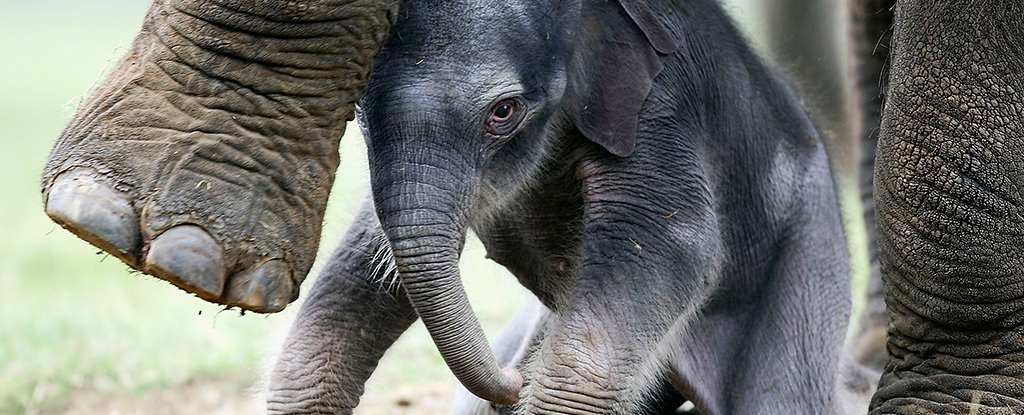Products You May Like
Over many thousands of years, a species of animal that shared a close relationship with wolves slowly morphed into something that loves to curl up in your lap, get belly rubs, and eat kibble three times a day.
These changes in dogs weren’t just behavioral. In fact, the changes in body plan – like shorter snouts, floppy ears, more expressive faces, less body hair, and prolonged infancy – are common to many domesticated animals.
An international team of researchers recently pointed out that similar features exist within populations of elephants, prompting the question of who or what might have domesticated them.
The answer the researchers propose sounds just as surprising: Elephants may have domesticated themselves.
On a fundamental level, domestication is the process of artificially selecting representatives from each generation of animal (or plant) that suit the best criteria for living among humans. Number one on that list has to be ‘play nice’. Nobody wants to wrestle a big, hairy mammal for its milk or risk their eyes for a morning fried egg.
While many common traits might not be intentionally selected for, some genes go hand-in-hand with those for a docile companion, giving many animals a more slender, less threatening look. Termed ‘domestication syndrome‘, the collection of characteristics that go with calm, cute, and content animals might not help them in the wild, but it certainly makes them more suitable for human society.
Back in 2017, Duke University anthropologist Brian Hare took the concept of domestication syndrome a step further, speculating whether it might apply to us humans as well.
If we could pick which dogs, sheep, pigs, and cows should have babies based on their temperament and attraction, why couldn’t we have done it to ourselves?
Known as the Human Self-Domestication Hypothesis, it presumes our evolution was increasingly guided from the middle to late Paleolithic by a preference for less-aggressive, more pro-social partners.
Consequently, there was increased pressure on our ability to communicate, facilitating complex language skills. Changes in how our brains function may have had an impact on our skull’s size and shape, not all that dissimilar to how skulls have changed in domesticated animals.
We might not be the only primates to have experienced this preference for a more peaceful, expressive path over a violent existence. Hare identifies our close relative, the bonobo (Pan paniscus), as a candidate for self-domestication based on assertions of the species’ lack of aggression compared with its other close relative, the chimpanzee.
Now African and Asian elephants are being nominated as two new examples of self-domestication, having arguably undergone similar selection processes as humans and bonobos.
The authors of this study supplied an extensive laundry list of similarities between the groups that serve as evidence of a shared domestication process. For example, in all three cases, the jaw and cranium have changed shape, with jaws shortening or skulls becoming less elongated, and teeth reducing in number.
Behaviorally, there’s a propensity for peaceful interactions, with examples of aggression tending to be proactive rather than reactive. Infants in all species tend to engage in social and non-social play that often facilitates socializing and bonding. There is also significant evidence of ‘alloparenting’, where offspring are guided and cared for by adults who aren’t their direct ancestors.
The team conducted a review of hundreds of genes speculated to be involved in changes to embryonic tissues considered to be in part responsible for domestication, finding some evidence that evolution has favored at least a few dozen such sequences in elephants.
The examples provided may be simply cases of cherry-picking what fits. For example, other animals that have undergone domestication develop into breeds with floppy ears and curly tails.
The researchers argue “domesticated species do not usually show the full suite of features associated with domestication”, as different blocks of traits can fragment and no longer undergo selection. Meaning elephants are less likely to lose the already evolved structure in their ears, given how useful they are for thermoregulation.
To what degree the three species of elephants might or might not have taken the evolutionary road to pro-social, domestic ‘bliss’ depends mainly on whether the hypothesis itself makes for a good theory capable of explaining why certain social characteristics might be commonly found in diverse species.
If it does, we might find other animals on a continuum of domestication. Dolphins, perhaps, or various species of birds or rodents might have also undergone similar changes that favor degrees of social complexity over brawn and fury.
Once seen as an exclusive virtue of humanity, the tendency to prioritize peaceful guidance, complex emotional expression, and a general love for one another might be an option open to many social animals.
As with many traits that once defined our species, humans have simply taken domestication to the next level.
This research was published in PNAS.
A version of this article was first published in April 2017.
